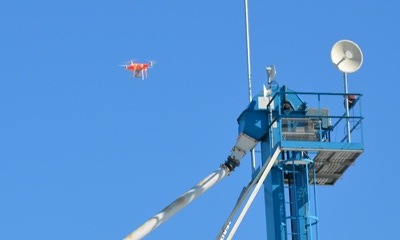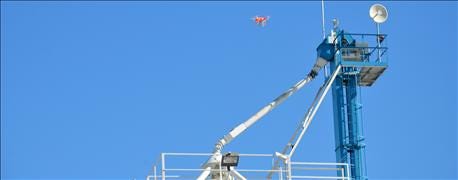
The sky is bright blue. It’s easy to see the orange 4-pound unmanned aerial vehicle as long as it isn’t flying directly into the sun. Some 150 people watch the demonstration. Suddenly, it appears as if the UAV is headed toward a blue elevator leg and seed tower. The crowd holds its breath, fearing the worst.
|
NO CRASH! It appears the tiny orange UAV is headed straight for the elevator tower. No crash ever happened. Crash-avoidance technology prevented it. |
Chad Colby isn’t worried. He’s putting on the aerial demonstration, and he’s confident the drone won’t crash into the elevator leg or seed tower. Colby, general manager of Central Illinois Ag, a Case IH dealer near Atlanta, Ill., knows the helicopter-style DJI Phantom UAV is equipped with crash-avoidance technology. Once considered a pipe dream, this technology is now showing up frequently on newer UAV releases.
Sure enough, the drone comes within a few feet of the obstacles, stops, hovers and doesn’t go any closer. No boom, no crash, no damage! Soon the UAV is back flying where there are no obstacles.
“Ag technology is ready to explode, and advances in UAVs are part of it,” says Colby. He’s traveled all over the world researching and sharing his knowledge about UAVs.
“We may not be living in the age of 'The Jetsons' [20th century animated space-age cartoon], but we’re not far from it,” he says. “All types of new technology will be coming to agriculture. It’s where we’re going to pick up the next 5, 10, eventually 50 bushels per acre so that we can meet global food need.”
Object tracking
One of the newest features in drones is object tracking, Colby says. He proved his point to the crowd that had just watched the crash-avoidance demo by asking a volunteer to start walking away. He dialed in controls on the UAV, and let it go to work. It moved toward the individual, slowly at first. As he kept walking, the UAV continued following, maintaining a constant altitude in the air.
Automated flight
Programmable drones that can fly missions have existed for a while. What’s happening now, Colby says, is that automated flight is becoming more common and more sophisticated. He programmed a drone to take off, fly a mission and land without any intervention, with the crowd watching.
You’ve seen pictures of someone grabbing the base of a drone as it comes back toward the ground. That’s not necessary with newer models, Colby says. They can land safely on their own.
“And it’s not just on drones that are super-expensive anymore,” he adds. “The drone used in the demonstration costs around $2,000, and that includes everything I need to fly it except the iPad.”
No steering wheel?
You think autosteer is cool? Colby rode in the Tesla automobile when the demo driver took his hands off the steering wheel. The car changed lanes and did everything it was supposed to do without the driver grabbing the wheel.
“It was kind of scary riding in there, but the technology definitely worked,” Colby says. “By 2021, there will be cars that don’t even have steering wheels. This technology is coming, and it’s coming very soon.”
The hard part, Colby says, will be keeping up with technology. “The UAV industry is a good example,” he says. “One-third of the companies in that business never make it through their second year!”
About the Author(s)
You May Also Like





